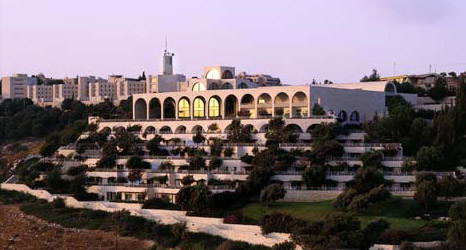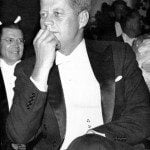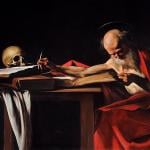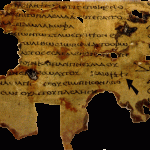
On Thursday, after visiting the Pool of Bethesda and the Church of St. Anne, our little group proceeded up the Via Dolorosa — with a stop at the Chapel of the Flagellation (on the site of the old Roman Antonia Fortress), which commemorates the torture of Jesus at the hands of the Roman soldiers who were his captors.
Then we headed out the Jaffa Gate for our hotel.
On Thursday evening, we attended a special program and reception at BYU’s Jerusalem Center for Near Eastern Studies. It was remarkably well done, including musical performances from a classical pianist and from a trained operatic singer (“Un Bel Di” [“One Fine Day”] from Puccini’s Madama Butterfly) who are among the Center’s current students and a Bach fugue from the Center’s organist, played on what is almost certainly the finest organ in the Middle East. Jim Kearl, who teaches economics at BYU and who has been the overall Provo-based boss of the Jerusalem Center for many, many years, spoke to the group, as did Utah’s Governor Gary Herbert.
This morning, Friday morning, we began by taking the group to the Church of St. Peter in Gallicantu, traditionally the site of the palace of the high priest Caiaphas and, accordingly, the place where Peter denied knowing the Savior (before the crowing of the cock, which explains the name Gallicantu). Also of interest is the flight of ancient steps leading up from the valley below to the possible site of palace and beyond. They date to the time of Jesus and would have been a principal route to the Upper City. We then walked over to the Jerusalem Archaeological Park, at the southern end of Herod’s temple platform, where we concentrated on the Herodian street and the evidence of the Roman destruction in AD 70 and on the first-century steps leading up to the Huldah Gates. These are steps on which the Savior and his disciples almost certainly walked as they ascended up to the temple from the Pool of Siloam (located today in the Arab village of Silwan) in the Kidron Valley below. In other words, yes, more steps. But important steps.
We spent some time at the plaza before the Western Wall — decreasingly, today, known as the “Wailing Wall”; the latter term is felt to be demeaning — and then were led by a special local Israeli guide on a tour of the Kotel Tunnel. It pays to be in the company of a VIP, because we not only had a superb and unusual guide through the tunnel but we were taken into a newly discovered place that has only been announced very recently and to which general access is not yet permitted: See “‘Jerusalem’s Lost Theater’ and 8 Ancient Stone Courses Discovered Under Western Wall.”
After leaving the Kotel Tunnel, we had lunch at the edge of the Old City’s Christian quarter (at a little cafe where we always eat while touring in the area) and then made a brief visit to the Church of the Holy Sepulcher — a place with which I have a long-standing love-hate relationship. From there, we exited the Jaffa Gate and caught our bus over to the Garden Tomb. Following which — out of order, I know, but there were unavoidable reasons — we went over to the Church of All Nations and the Garden of Gethsemane in the Kidron Valley. And some of us walked from there up to the Orson Hyde Garden, which sits somewhat above and slightly to the north of Gethsemane.
This evening, my wife and I relaxed with a really good dinner at the Adom Restaurant, located in the old “First Station” at 4 David Remez, Jerusalem. I strongly recommend it.
Wish you were here.
Posted from Jerusalem, Israel










